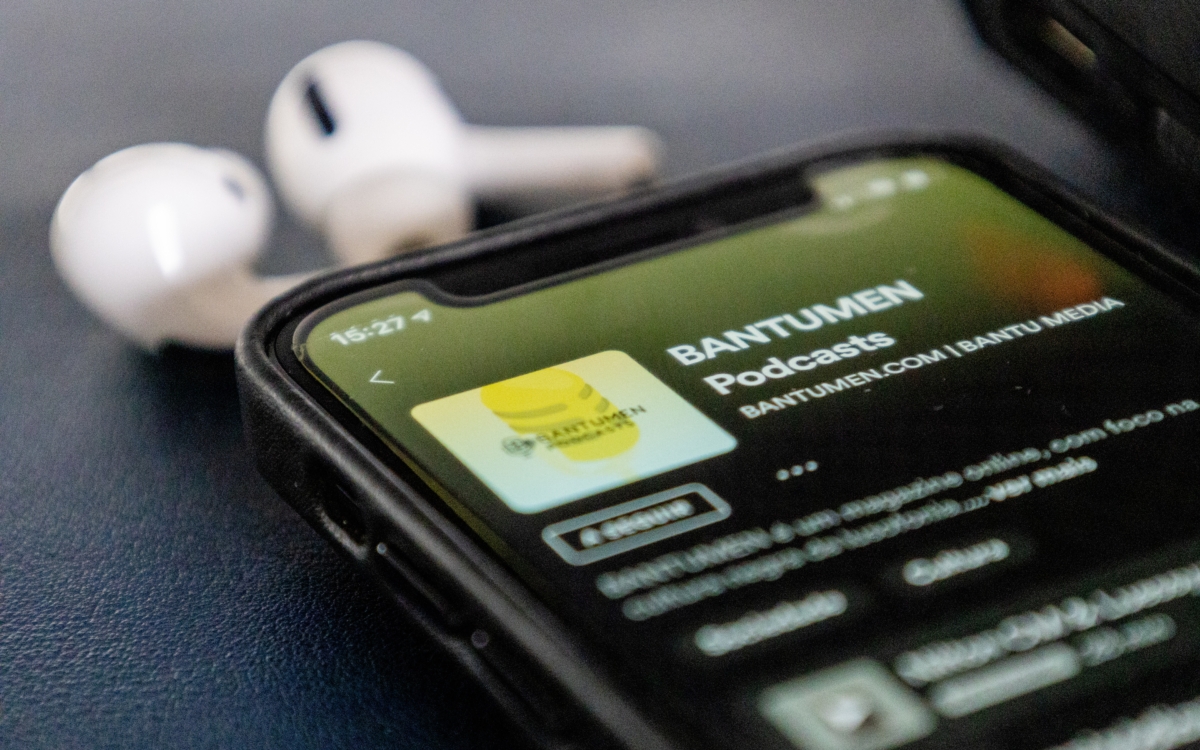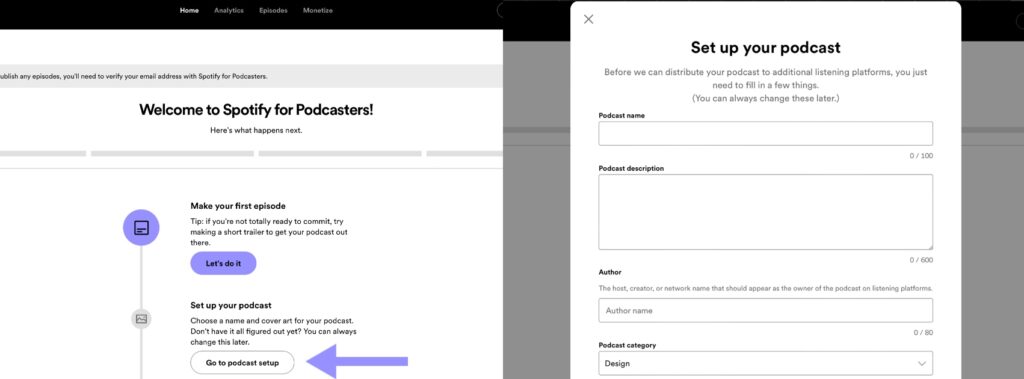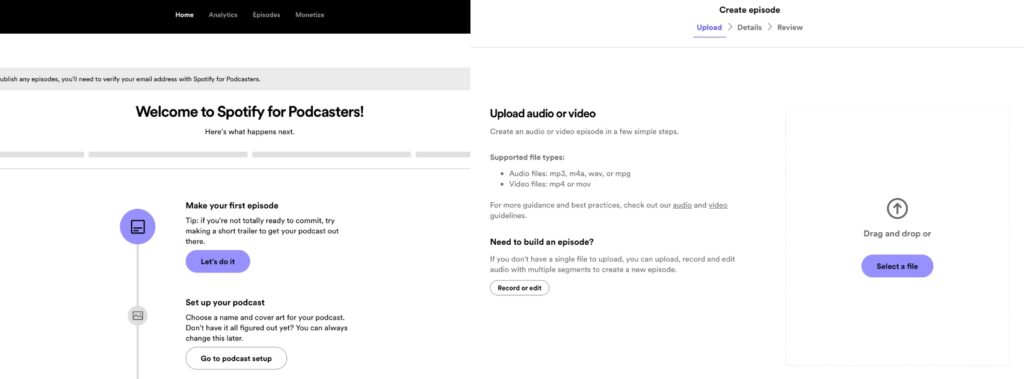How To Start A Podcast On Spotify: 5 Easy Steps To Get Going Today

When you buy something through one of the links on our site, we may earn an affiliate commission.
Want to learn how to start a Spotify podcast?
Good thinking. Spotify has 574 million active users today, meaning your podcast has a massive potential audience.
The best part? Spotify for Podcasters is simple to use—no need for fancy gear or expert skills. And once your show is up, there are plenty of ways to promote it and grow your audience.
In this guide, we'll walk you through the entire process of launching your podcast on Spotify and reaching as many listeners as possible.
Let's begin!
Contents
How To Start A New Podcast On Spotify
Before we go through the steps, let's explore why Spotify is the go-to platform for thousands of podcasters.
Firstly, it’s one of the most user-friendly options available and perfect for newbies in the podcasting world. Secondly, the platform is 100% free for hosting, creating, and distributing podcasts.
Additionally, Spotify offers multiple features for engaging with audiences, such as Q&As and video episodes for an intuitive experience. You also get various tools for monetizing content, which keeps your finances ticking.
All of this, combined with the massive audience of active users, makes Spotify a top choice for starting a podcast, and here are the steps to do so:
1. Create A Podcast Account On Spotify

The first step is to create an account on Spotify for Podcasters. Go to podcasters.spotify.com/getstarted/new and choose between the following options:
- I want to start a podcast
- I have a podcast
If you're starting a brand new podcast, select the first option. You can log in with your existing Spotify account or create a new one for this purpose.
But if you're already hosting a podcast on a different platform, select the second option. Spotify will ask you to pick your current host from their list, after which you can skip to step 4 for further instructions.
2. Setup Your Spotify Profile

Once you've signed up, Spotify will guide you through a setup process to launch your podcast. At this stage, skip the episode upload option and click on the Go to podcast setup button instead.
To set up your channel, you will be required to fill in the following information:
- Podcast Name: Start by choosing a name for your podcast. Think of something that's both unique and memorable. If you're looking for inspiration, check out our list of 100 Podcast Names For Your New Show.
- Podcast Description: Write a short description of your podcast, the hosts, the topics you discuss, and a call to action that encourages people to tune into your show regularly.
- Author Name: Add the name of the founder/owner of your podcast.
- Podcast Category: Select a category that directly reflects the theme of your podcast.
- Podcast Language: Choose the main language of your podcast.
- Cover Art: Upload the existing cover art of your podcast. If you don't have one, design something that's vibrant, attractive, and conveys the essence of your show.
By following these steps, you can craft a Spotify podcast profile that leaves a lasting impression.
3. Upload Your Podcast Files

After setting up your Spotify profile, the next step is to upload your first podcast episode. To do so, click on the Let's do it button.
On this page, you can upload your already polished audio or video episodes. Or, if you're starting fresh, you can click on the Record or edit to shoot an episode right on the platform. When you're done, hit the Save Episode button to continue.
Next, you will need to provide a Title and Description for your podcast episode. Choose whether it contains explicit material, and set it to publish immediately or schedule it for later. You can also access advanced options like season/episode number, cover art, and video type.
After you're done, click on the Next button, preview your podcast episode details, and hit Publish.
4. Connect and Verify Your RSS feed (Alternative Method)

If you chose the 'I have a podcast' option on the startup page, you probably have an existing podcast show and want to integrate it with Spotify.
For this purpose, you need an RSS link. A podcast RSS feed is essentially your show's lifeline to the world. It's a URL that both websites and podcast platforms use to share and update content.
With an RSS feed, connected apps like Apple Podcasts or Amazon Music will automatically pick up and display your latest episodes as you add them. Without it, you'd be stuck manually updating each platform with your podcast audio files every time.
Returning back to the topic, select where you're currently hosting your podcast show from the above options. After that, you will be redirected to the welcome screen. Click on Get Started to continue.

On this page, enter your RSS feed link and click on Next. Once Spotify has recognized the link, it will show a preview for confirmation. To move forward, click on Next again.
Now, all that's left to do is verify your ownership of the RSS feed. Press the Send Code button, and Spotify will email you an 8-digit confirmation code on the email address attached to your hosting platform.
Hosting a podcast On Spotify (Optional)

Spotify is not just a streaming platform but a podcast hosting service as well. If you want to switch to Spotify’s native platform to host your show, here are the steps:
1. Start at Spotify's Switching Page: Head to podcasters.spotify.com/switch and enter your podcast's dedicated RSS link or name in the search field.
2. Set up or import your account: Create a new Spotify for Podcasters account or import your podcast into an existing one.
3. Redirect Your RSS Feed: The last step is crucial—redirecting your RSS feed to your new Spotify URL. This step varies with different hosting providers, so follow their specific guidelines for a seamless switch.
Once you've made the move, you're all set to use Spotify's full suite of features, whether that's uploading content or crafting new episodes with their built-in tools.

Once your podcast is up and ready, it's time to spread the word and promote your show to a larger audience.
The best way to do this is by sharing your podcast on other apps using your RSS feed link. This way, listeners on Amazon Music, Apple Podcasts, Castbox, and Overcast can also receive the latest updates and stay in the loop with your episodes.
You can enable this option under Settings > Podcast Availability > RSS Distribution and then clicking on Enable RSS Feed. Copy the provided link and paste it into other podcast directories to maximize your podcast's reach.
Spotify also lets you connect to Facebook, Twitter (X), Instagram, and YouTube under Settings > Podcast Settings > Connections for quick sharing whenever you publish a new episode.
Requirements For Spotify Podcast Creators
Spotify for Podcasters comes with a few key requirements. When uploading/recording a new episode or starting your show, remember to follow these guidelines for a smooth podcasting experience on Spotify:
- Video quality: MOV or MP4 with H.264 profile, 16:9 aspect ratio, and maximum bitrates of 25 Mbps for 1080p source or 35 Mbps for 4k source
- Audio quality: MP3, M4a, WAV, or MPG with support for ISO/IEC 11172-3 MPEG-1 Part 3 standard and bitrate of 192 Kbps or higher.
- Cover art: 1:1 ratio in high-res PNG, JPEG, or TIFF formats.
- RSS feed: Include a title, cover art, and details for at least one episode.
- Titles and descriptions: Keep them under 20 characters to avoid truncation. Special characters? HTML code them.
- File size: Keep the episodes under 200MB.
- Episode length: They must stay under 12 hours.
Creating Podcast Episodes for Spotify
Starting a new podcast is no easy job. Most professional shows we watch have a lot going on in the background, with teams of 5-10 people handling several processes.
While we don't expect you to invest in big studios or expensive gear, it is important to know the basics of running a successful podcast so you can deliver top-notch quality episodes from the start:
Pre-Production
1. Planning topics: Decide the topics you want to cover and how they relate to your guest. Look at social media trends to identify what people want to hear.
2. Choosing guests: Start searching for guests weeks in advance to prep them for the show. Target individuals recognized as an authority on your chosen topic.
3. Podcast schedule: Use a podcast planning template to manage your workflow, from scripting to guest outreach.
For an in-depth guide on podcast production, check out How To Interview Someone For A Podcast: 12 Essential Tips You Need To Know.
Recording
1. Environment matters: Choose a quiet, acoustic-friendly space for recording. If needed, use Spotify for Podcasters’ Audio Enhancement tool to reduce ambient noise.
2. Equipment check: Ensure your recording equipment is ready and devices are charged. Do any mic checks and camera adjustments before the guests arrive.
Editing and Post-Production
1. Editing: Utilize editing software like Adobe Premier Pro or DaVinci Resolve to refine your audio/video and remove any extra footage.
2. Adding elements: Spread some sound effects or background music throughout the video to create an ambiance and make the episode more engaging.
3. Branding each episode: Craft a compelling title, episode-specific artwork if possible, and a descriptive summary using keywords relevant to the episode.
Each of the above steps is vital in producing a podcast episode that resonates with your Spotify audience and enhances your podcast’s quality.
Check out our article on creating a podcast intro that hooks listeners.
Tips for Spotify Podcast Growth
An engaging, well-executed podcast is nothing without an effective marketing strategy. To amplify your podcast's reach and ensure it connects with the right audience, it's crucial to implement a mix of strategies.
Fortunately, Spotify for Podcasters has several tools to help you in this process. Here's a comprehensive approach to boosting your podcast's growth:
1. Optimize for discovery: Make sure your podcast website/page is captivating and optimized for SEO. Your episode title, descriptions, and show notes are crucial in making your podcast easily discoverable in multiple search engines and podcast directories.
2. Leverage analytics to see progress: Understanding what success looks like for your podcast is essential. Define your goals, whether it’s getting more listeners, subscribers, or engagement. Utilize Spotify for Podcasters’ analytics dashboard to gauge your show's performance. This data, available on both desktop and mobile, can help improve your strategy and inspire future episodes. Or you can keep tabs on your podcast analytics with an advanced tool such as Transistor to see how your show performs.
3. Promote with Promo Cards: Utilize Spotify’s Promo Cards to create personalized, Spotify-branded promotional materials. These can be shared on social media to enhance visibility and attract more listeners.
4. Tap into editorial opportunities: Spotify’s editorial team is always on the lookout for new talent. Submit your podcast to their editorial submission form to be featured in Spotify’s community destinations or New Releases section (learn more about podcast submission sites here).
5. Boost audience engagement: Engaging with your podcast audience is crucial for building a loyal fan base. Spotify for Podcasters provides in-app features like Q&A and polls to interact directly with your fans during and after episodes. Also, maintaining a unique presence on social media can help listeners feel more connected to your podcast content.
Spotify Podcast Monetization
Spending hours uploading and editing podcasts without earning a single dollar isn't particularly motivating.
Luckily, Spotify offers a variety of built-in monetization options for creators, such as:
- Subscriptions: You can charge your listeners a monthly subscription fee and offer exclusive perks for being a paid community member. We generally recommend using this model at a later stage when your podcast has developed a decent fanbase.
- Host-read ads: Spotify podcasters can record and promote ads about them promoting the platform in exchange for earnings. This monetization model is perfect for beginners and pays you for every person who watches your video.
- Listener support: Hosts can build opportunities to collect donations and tips from regular watchers on Spotify for Podcasters. While you shouldn't expect to earn a full-time income from this, donations can be highly encouraging for beginners.
Apart from that, you can also activate third-party ads to automatically run between show breaks. This feature is currently in its beta stage but will be rolling out to more regions in the near future.
Podcast hosts also have the opportunity to promote merchandise, affiliate products, or coaching programs on their podcasts to establish multiple income streams.
Closing In On Starting a Spotify Podcast
There you have it: a comprehensive guide on how to start a podcast on Spotify. From setting up your account to optimizing for growth, each step is designed to help you make the most of the platform.
As you begin your podcasting journey with Spotify, remember to leverage its full potential to connect with listeners, share your stories, and build your brand.
Wondering how lucrative a podcast business can become? Read our list of 40+ Podcast Statistics That Will Convince You To Start One Today!
Want to learn step-by-step how I built my Niche Site Empire up to a full-time income?
Yes! I Love to Learn
Learn How I Built My Niche Site Empire to a Full-time Income
- How to Pick the Right Keywords at the START, and avoid the losers
- How to Scale and Outsource 90% of the Work, Allowing Your Empire to GROW Without You
- How to Build a Site That Gets REAL TRAFFIC FROM GOOGLE (every. single. day.)
- Subscribe to the Niche Pursuits Newsletter delivered with value 3X per week
My top recommendations


















